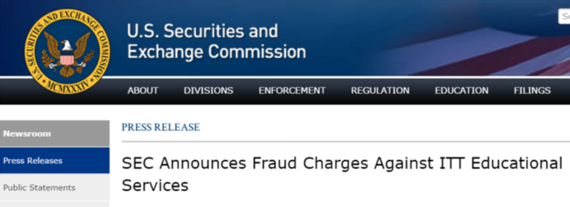The Securities and Exchange Commission yesterday announced fraud charges against ITT Education Services, a for-profit company that operates career training schools. The SEC alleges that ITT executives engaged in a scheme to hide looming losses from loans the company guaranteed to students attending its colleges. The company denies the fraud.
Regardless of whether investors were misled, why on Earth would a company make or guarantee loans that it expects many borrowers will not repay? I will explain.
There are three steps to getting rich off the federal college aid programs. First, you target students who qualify for the largest amount of government aid. That would be the low-income adults, Obama moms, who qualify for about $15,000 in grants and loans. Second, you figure out how to spend as little as possible on the actual education: offer classes online or in an office building, use a standardized curriculum that does not require labs or equipment, and hire part-time instructors. Don't list your faculty on the web site; certainly don't give anyone tenure. The large for-profit companies typically spend less than one-fifth of their revenue on actual teaching.
Third, focus the largest portion of your government-provided revenue on advertising and recruiting. That way, enrollment grows fast, without the need for additional investors. Enrollment in ITT schools grew quickly, from 28,000 in 2000 to 88,000 in 2010. Like magic, a small investment leverages taxpayer funds that can lead to billions of dollars of "shareholder value."
Except there is one little regulation that you have to watch out for. Because of similar previous scandals, the government requires for-profit colleges to demonstrate that they have at least a few real customers, people who are paying for the education without federal aid. This rule is called 90-10 because schools must show that they get at least ten percent of their revenue from somewhere other than the U.S. Department of Education.
There are two different ways a school can meet the 90-10 requirement: an ethical approach, and a scheme that perverts the underlying purpose of the rule. In the 1990s, the University of Phoenix did it the right way. The pioneering for-profit marketed itself to employers and mid-career professionals who were paying with their own money. These customers had both the knowledge and the financial incentive to insist on value (price and quality together), and the college was better for it. In 2000, the company reported that about half of its students had their tuition paid by their employers.
Then there is the other way of satisfying the 90-10 requirement, reducing to nearly zero the number of students who are analyzing whether the education is worth the price. Low-income students in particular make the reasonable assumption that the government wouldn't allow financial aid to pay more tuition than is appropriate, and they trust the friendly recruiter who tells them that the college has what they need. Some for-profit colleges fill the ten percent with veterans, because GI Bill funds are ignored by the 90-10 formula (and vice-versa: the Education Department funds are ignored by the GI Bill's 85-15 requirement). But there are a limited number of veterans to pursue, and targeting veterans for schooling of questionable value tends to invite scrutiny. 
ITT Education and many other for-profit colleges adopted a top-up approach to evade market accountability. Rather than finding actual customers who would pay $15,000 for an education worth, say, $5,000, the school posts a price of $18,000, collects the $15,000 in aid from the government, and asks the student to pay $3,000. If the student can't pay the $3,000, the school arranges for a private loan. Those are the private loans that got ITT Education in trouble with the SEC. So-called Peaks loans, the top of the tuition mountain, were used to fill the ten percent pool; the company could guarantee the loans because even if many borrowers defaulted the school would still bring in a lot more revenue than the company spent. In 2009 ITT had a profit margin of more than 37 percent, among the highest in the industry.
The top-up approach is now so common among for-profit colleges that it is frequently but incorrectly believed to be what the 90-10 rule actually requires. A recent U.S. Senate white paper repeats the false claim that colleges "must raise their tuition in order to generate revenue that is not counted as federal funds." Baloney. The 90-10 rule can and should be met with paying customers, as evidence that the school is offering a quality education at a reasonable price.
The SEC took action because investors may have been misled. But the real victims are not investors, they are the students who didn't get the education they deserved, and whose credit has been destroyed by student loans they never should have had to take out. The students, and taxpayers, should be repaid by the executives and investors who made a bundle by manipulating students and the federal financial aid programs.
